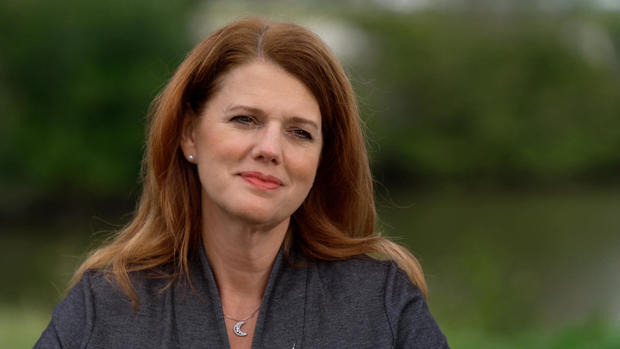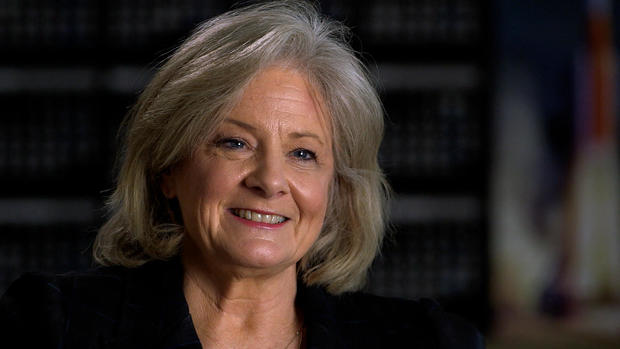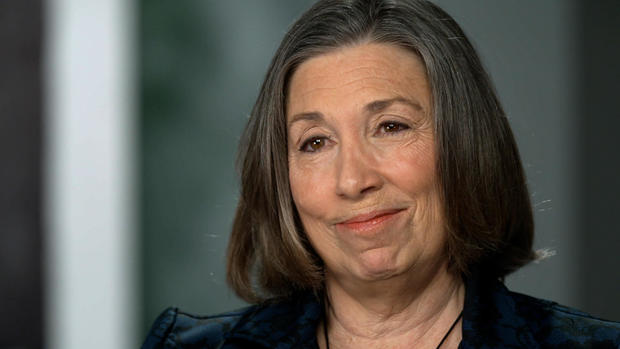Twelve American men have walked on the moon. The last Apollo astronaut left his footprint there in December 1972. Now, a half-century later, NASA is planning to send people back to the moon. The new program is called Artemis, after Apollo's mythical twin sister, and the goal is that the next footprint on the moon will be made by a woman. The astronaut who gets that assignment hasn't been chosen yet.
As you're about to see, this new push to the moon has been plagued by doubts, cost overruns, and delays. But we found something else interesting when we visited NASA: the Artemis program isn't just named for a woman, it's largely being run by women
Charlie Blackwell-Thompson: So there is no place on launch day that I would wanna be but right here.
Charlie Blackwell-Thompson is NASA's first female launch director.
In a year or so, she'll give the "go for launch" command for the first Artemis moon rocket in historic Firing Room One at Kennedy Space Center, which she first visited more than 30 years ago as a college graduate interviewing for a job.
Charlie Blackwell-Thompson: It's the same room that the Apollo 11 mission was launched from. And it is the same room that we will launch the first flight of the Artemis missions.
Bill Whitaker: When that young woman walked in here for the first time, did you truly say to yourself, "I want to do this one day"?
Charlie Blackwell-Thompson: I absolutely did. My-- my thought was, "How do I get a seat in this room?
Bill Whitaker: And now you have "the" seat in the room.
Charlie Blackwell-Thompson: I have a pretty nice seat in this room. (LAUGHTER)
All the Apollo moon missions were launched atop huge Saturn five rockets, at the time the most powerful in the world. NASA's new rocket is even more muscular.
Bill Whitaker: Can you put it into words how powerful this new rocket is?
Charlie Blackwell-Thompson: The core stage will have hundreds of thousands of gallons of propellant. Over eight million pounds of thrust at liftoff.
The most powerful rocket ever is called the Space Launch System, or SLS. In development for a decade, it has yet to fly; and has only fired its four main engines once, in a test.
Jody Singer: It is hard work cheating gravity.
Jody Singer is another female first for NASA: as the first woman to run Marshall Space Flight Center in Alabama, it's been her job to build the SLS, which is designed to go to the moon and beyond.
Jody Singer: It is built for going to deep space. And right now, it's the only vehicle that exists that can carry the Orion and take what it does to be able to go to deep space.
The Orion is the capsule that astronauts will ride on top of the SLS rocket. The first one is ready to go. The lunar lander is still in the "concept" stage, but NASA doesn't really need it until the third Artemis moon mission.
Charlie Blackwell-Thompson: Artemis I is about testing out this integrated vehicle, SLS with Orion. Artemis II is about the incorporation of the crew, and preparing us for Artemis III. Where, then, we will go to the surface of the moon.
Bill Whitaker: Do you hear yourself, and how cool that sounds?
Charlie Blackwell-Thompson: It does sound pretty cool.
Another cool piece of the Artemis plan is a space station called Gateway, meant to orbit the moon.
NASA intends to use Elon Musk's company SpaceX to launch Gateway's components on one of its Falcon Heavy rockets.
The Falcon Heavy is already flying, its first launch sent Musk's Tesla Roadster toward Mars a couple of years ago; yes, that really happened. Jody Singer says SpaceX is an illustration of NASA partnering with commercial launch providers.
Jody Singer: We work together. And I think working together, that is how we will be able to deliver on the Artemis program. We both bring great things on this partnership.
When that partnership will actually deliver women and men to the moon is uncertain. Donald Trump set 2024 as the goal; that was seen by insiders as unrealistic. President Biden hasn't set a timetable, but his White House has given the idea of Artemis an early thumbs up.
White House Press Secretary Jen Psaki at briefing: ...another man and a woman to the moon, which is very exciting.
Bill Whitaker: What does it say about NASA that you are in these positions in what used to be a totally male dominated sphere?
Jody Singer: Well, number one, I'd say we've come a long way. You know, Charlie and I we know we've known each other for at least 20 years. We liked each other. But also, we were, you know, sometimes the only women in the room.
Not any more. Charlie Blackwell-Thompson says that on launch day, 30% of the engineers in what's now her firing room will be women.
Bill Whitaker: Have you always been interested in space, when you were a little kid, even?
Charlie Blackwell-Thompson: I remember the last Apollo missions, the last couple. And I can remember the sense of curiosity and awe. I could go outside and I could look up at the sky, and that our astronauts were visiting the moon.
The pool of 18 Artemis astronauts has already been chosen. Nine women, nine men. Six of whom are test pilots, four have Ph.D.'s, three are medical doctors. It's not known yet which of them will fly to the moon, but two are in space right now on the International Space Station.
Bill Whitaker: Why the moon? Why put out the expense to return to the moon?"
Charlie Blackwell-Thompson: We are still learning from the samples that were returned during the Apollo program. There is so much science-- so much scientific discovery to come from returning to the moon.
Scientists are especially tantalized by recent evidence that there's a lot of ice near the moon's South Pole. That's exactly where Artemis is meant to land. Ice means H2O, which means water to sustain life, and hydrogen and oxygen to potentially turn into rocket fuel.
Charlie Blackwell-Thompson: I would point to the moon being-- a proving ground, a waypoint, for us to learn how to live in Deep Space when we're only days from home, versus months or years, for destinations like Mars.
Lori Garver: And it will be great when we go back, and we-- especially will be great if we, this time, can stay.
Lori Garver was the number two official at NASA during much of the Obama administration. She wants America back on the moon, but believes the current approach is the wrong way to get there.
Lori Garver: I would not have recommended the government build a $27 billion rocket, when the private sector is building rockets nearly as large for no cost to the taxpayer.
She's talking about rockets like Elon Musk's Falcon Heavy.
Garver was an early advocate of turning all the development of big new rockets over to private companies like SpaceX.
Lori Garver: But the Congress had a different goal. Their goal was really to extend the contracts and jobs in their districts.
At the time - 2010 - the space shuttle was about to be grounded and members of Congress feared that aerospace jobs in their districts would go away too.
Bill Whitaker: The SLS, the Space Launch System, is mockingly referred to as the Senate Launch System. Can you explain to us why it's got that nickname?
Lori Garver: In this case, it was the Senate who came to us at NASA and said, "No, we don't like your plan. And we are going to make you build it this way."
So Boeing, prime contractor for the space shuttle and longtime NASA partner, became the prime contractor for the SLS.
Lori Garver: The industry said they would do it for $6 billion in six years. That was the rocket. It's been $20 billion in 11 years.
NASA's Jody Singer acknowledges the delays and cost overruns, but insists it's the right model.
Jody Singer: The Space Launch System, I'm proud to say, has work that's over 45 states and over 1,100 vendors. So the Space Launch System is a national vehicle. That means jobs. That means that, across the nation, for the SLS alone, there's over 25,000 people that have jobs.
Lori Garver: It's ironic, honestly, that NASA, the very symbol of a democratic and capitalist society-- has done a lot of its human spaceflight programs in more of a socialist way.
Bill Whitaker: More in a socialist way. (LAUGH) I think many of the senators whose districts are getting these NASA jobs would balk at that description.
Lori Garver: You will plant the potatoes in March. You will build your rocket in my district. That's - that's what it is.
The top-down approach, Garver says, has produced a NASA SLS rocket that'll cost more than $2 billion for every launch, while SpaceX flies its Falcon Heavy for a fraction of that.
NASA's SLS can launch a heavier payload, but it's a use-it-and-lose-it rocket; none of its parts can be reused. By contrast, spacex booster rockets make soft landings after launch, so they can be used over and over. Two of its first stages have already been launched eight times each!
Bill Whitaker: Am I missing something in saying that this is the new way, and what's going on with NASA is the old way?
Charlie Blackwell-Thompson: Well, I probably wouldn't characterize it as "the new way" and "the old way." I would probably characterize it as just different ways. I would say that our rocket was designed based on proven technology.
Bill Whitaker: So you wouldn't say it's "old," it's "proven"?
Charlie Blackwell-Thompson: I would say it's "proven."
Still, the SpaceX rockets are proven enough that NASA now trusts them to carry its astronauts to the International Space Station.
Those successful missions should not be confused with an entirely new rocket called starship that SpaceX is testing in Texas. Three test flights so far, all three ending in spectacular explosions… the latest one just last week.
Bill Whitaker: So should NASA pivot and start relying on SpaceX and commercial launchers-- for the moon and beyond?
Lori Garver: Undoubtedly. We should've before now.
Bill Whitaker: Is NASA capable of making that shift?
Lori Garver: Oh, of course. I mean, NASA is capable of more than they-- they realize.
Bill Whitaker: Now, considering all you have told me, will Congress let NASA make that shift?
Lori Garver: Probably not.
For the moment, the core stage for the first artemis mission sits in a test stand in Mississippi – the same stand used for the Apollo missions. It's awaiting a test-firing, after technical glitches cut the first one short.
There are six American flags on the moon, one for each Apollo landing. But the newest flag there is Chinese, left last year by a robotic lander that collected samples and brought them back to earth. Beijing eventually plans to send astronauts.
Bill Whitaker: Aren't we in a space race with China?
Lori Garver: There is not a race to go to the moon. We won it. We won it six times. And I have no doubt that we will be back again with people before anyone else goes.
And Charlie Blackwell-Thompson will be the woman to launch them, from her seat in the firing room.
Charlie Blackwell-Thompson: We talk a lot about the moon, and I think the moon is phenomenal, and I can't wait to go back. But when we talk about those young people that may be like me when I was younger, looking up at the night sky and looking up at the moon, I want 'em to look up at the night sky and not be limited to the moon.
Produced by Rome Hartman. Associate producer, Sara Kuzmarov. Broadcast associate, Emilio Almonte. Edited by Craig Crawford.
Article From & Read More ( NASA's new race to put a woman on the moon - 60 Minutes - CBS News )https://ift.tt/2PL6d6z
Science



No comments:
Post a Comment